Play audio — original link
Play audio
Play audio
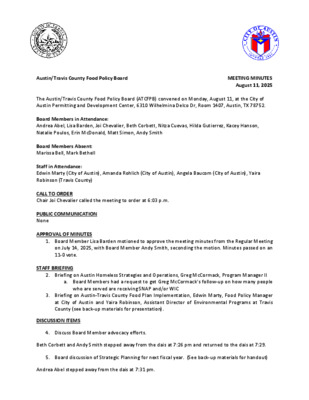
Austin/Travis County Food Policy Board MEETING MINUTES August 11, 2025 The Austin/Travis County Food Policy Board (ATCFPB) convened on Monday, August 11, at the City of Austin Permitting and Development Center, 6310 Wilhelmina Delco Dr, Room 1407, Austin, TX 78752. Board Members in Attendance: Andrea Abel, Lisa Barden, Joi Chevalier, Beth Corbett, Nitza Cuevas, Hilda Gutierrez, Kacey Hanson, Natalie Poulos, Erin McDonald, Matt Simon, Andy Smith Board Members Absent: Marissa Bell, Mark Bethell Staff in Attendance: Edwin Marty (City of Austin), Amanda Rohlich (City of Austin), Angela Baucom (City of Austin), Yaira Robinson (Travis County) CALL TO ORDER Chair Joi Chevalier called the meeting to order at 6:03 p.m. PUBLIC COMMUNICATION None APPROVAL OF MINUTES 1. Board Member Lisa Barden motioned to approve the meeting minutes from the Regular Meeting on July 14, 2025, with Board Member Andy Smith, seconding the motion. Minutes passed on an 11-0 vote. STAFF BRIEFING 2. Briefing on Austin Homeless Strategies and Operations, Greg McCormack, Program Manager II a. Board Members had a request to get Greg McCormack’s follow-up on how many people who are served are receiving SNAP and/or WIC 3. Briefing on Austin-Travis County Food Plan Implementation, Edwin Marty, Food Policy Manager at City of Austin and Yaira Robinson, Assistant Director of Environmental Programs at Travis County (see back-up materials for presentation). DISCUSSION ITEMS 4. Discuss Board Member advocacy efforts. Beth Corbett and Andy Smith stepped away from the dais at 7:26 pm and returned to the dais at 7:29. 5. Board discussion of Strategic Planning for next fiscal year. (See back-up materials for handout) Andrea Abel stepped away from the dais at 7:31 pm. 6. Review Board Member assignments a. Board Members to let Angela Baucom know if you are interested in serving on the Implementation Collaborative RFP Evaluation Panel. b. Amanda Rohlich to share link to Request for Proposal for Implementation Collaborative c. Joi Chevalier will send Amanda Rohlich the board talking points to share out with full board. d. Staff to explore documentation of any Austin City Council and/or Travis County Commissioners Court food-related budget recommendations on Food Plan Dashboard. e. Staff to share notes and record of last year’s strategic planning efforts. f. Andy Smith to share Bond Advisory Task Force WG meeting information to Amanda Rohlich to share with full board. g. Staff to request joint meeting from OEM and HSEM DISCUSSION AND ACTION ITEMS 7. Discuss and …
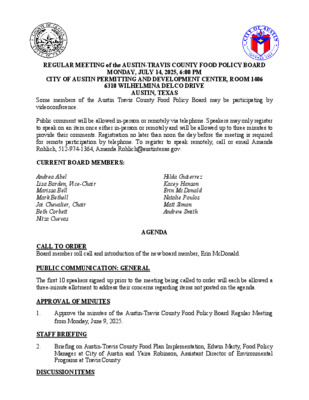
REGULAR MEETING of the AUSTIN-TRAVIS COUNTY FOOD POLICY BOARD MONDAY, JULY 14, 2025, 6:00 PM CITY OF AUSTIN PERMITTING AND DEVELOPMENT CENTER, ROOM 1406 6310 WILHELMINA DELCO DRIVE AUSTIN, TEXAS Some members of the Austin Travis County Food Policy Board may be participating by videoconference. Public comment will be allowed in-person or remotely via telephone. Speakers may only register to speak on an item once either in-person or remotely and will be allowed up to three minutes to provide their comments. Registration no later than noon the day before the meeting is required for remote participation by telephone. To register to speak remotely, call or email Amanda Rohlich, 512-974-1364, Amanda.Rohlich@austintexas.gov. CURRENT BOARD MEMBERS: Andrea Abel Lisa Barden, Vice-Chair Marissa Bell Mark Bethell Joi Chevalier, Chair Beth Corbett Nitza Cuevas Hilda Gutierrez Kacey Hanson Erin McDonald Natalie Poulos Matt Simon Andrew Smith AGENDA CALL TO ORDER Board member roll call and introduction of the new board member, Erin McDonald. PUBLIC COMMUNICATION: GENERAL The first 10 speakers signed up prior to the meeting being called to order will each be allowed a three-minute allotment to address their concerns regarding items not posted on the agenda. APPROVAL OF MINUTES 1. Approve the minutes of the Austin-Travis County Food Policy Board Regular Meeting from Monday, June 9, 2025. STAFF BRIEFING 2. Briefing on Austin-Travis County Food Plan Implementation, Edwin Marty, Food Policy Manager at City of Austin and Yaira Robinson, Assistant Director of Environmental Programs at Travis County DISCUSSION ITEMS 3. 4. 5. 6. 7. Presentation and discussion on Urban Programs from Travis County Extension Director, Maggie Moreno Johnson Discuss Board Member Advocacy Efforts Annual Internal Review Reminder Board discussion of Strategic Planning for next fiscal year Review Board Member Assignments DISCUSSION AND ACTION ITEM 8. Discuss and take possible action on a request for by-law amendment to update Travis County terms limits from 2 to 4 years FUTURE AGENDA ITEMS Discussion and scheduling of future agenda items. ADJOURNMENT The City of Austin is committed to compliance with the American with Disabilities Act. Reasonable modifications and equal access to communications will be provided upon request. Meeting locations are planned with wheelchair access. If requiring Sign Language Interpreters or alternative formats, please give notice at least 2 days (48 hours) before the meeting date. Please call Amanda Rohlich at Office of Sustainability, at 512-974-1364, for additional information; TTY users route through Relay Texas at 711. …
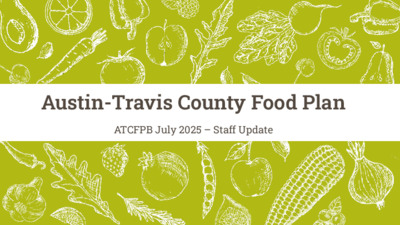
Austin-Travis County Food Plan ATCFPB July 2025 – Staff Update City of Austin Food Plan Updates Food Plan Dashboard Now LIVE City Staff Report Back to Council ● City staff will provide another Memo to Council in October 2025 ● City staff will provide a summary of the Food Plan Memo to the CWEP (Climate, Water, Environment, and Parks) Council Committee in fall 2025 Implementation Collaborative ● City and County staff developed an Interlocal Agreement to support a Food Plan implementation collaborative (Strategy 9.1) ● On May 8th, City Council approved an RCA to negotiate a contract with the County ● On May 13th, Travis County Commissioners Court approved the ILA with the City ● City staff are developing an RFP for support of an implementation collaborative. Will be released in mid-2025. ● Consultant should be on-board in fall of 2025. Food Plan Implementation Convening ● First Food Plan Implementation Convening occurred on May 9th ● Considering additional options for summer 2025 ● Next Convening in fall of 2025 Food Plan - Relevant Budget Events ● City Manager presents proposed draft FY 2025/2026 budget to City Council on July 15th. ● City Council will discuss budget until August ● City County will vote on next year’s budget on August 13th Travis County Food Plan Updates Travis County FY26 Budget Development ● Week of July 28: Preliminary budget published ● August 13-15 and 18 if needed: Potential budget hearings ● September 2-5 and 8 if needed: Budget markup ● September 30: FY26 Budget adoption Thank You! Travis County Environmental Quality: Sustainability Programs www.austintexas.gov/food /austinsustainability
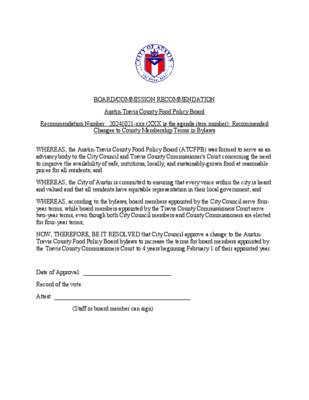
BOARD/COMMISSION RECOMMENDATION Austin-Travis County Food Policy Board Recommendation Number: 20241021-xxx (XXX is the agenda item number): Recommended Changes to County Membership Terms in Bylaws WHEREAS, the Austin-Travis County Food Policy Board (ATCFPB) was formed to serve as an advisory body to the City Council and Travis County Commissioner's Court concerning the need to improve the availability of safe, nutritious, locally, and sustainably-grown food at reasonable prices for all residents; and WHEREAS, the City of Austin is committed to ensuring that every voice within the city is heard and valued and that all residents have equitable representation in their local government; and WHEREAS, according to the bylaws, board members appointed by the City Council serve four- year terms, while board members appointed by the Travis County Commissioners Court serve two-year terms, even though both City Council members and County Commissioners are elected for four-year terms; NOW, THEREFORE, BE IT RESOLVED that City Council approve a change to the Austin- Travis County Food Policy Board bylaws to increase the terms for board members appointed by the Travis County Commissioners Court to 4 years beginning February 1 of their appointed year. Date of Approval: _____________________________ Record of the vote: Attest: _____________________________________________ (Staff or board member can sign)
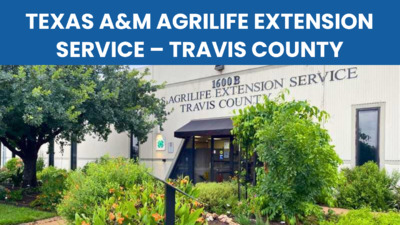
TEXAS A&M AGRILIFE EXTENSION SERVICE – TRAVIS COUNTY MAGGIE JOHNSON COUNTY EXTENSION DIRECTOR WIZZIE BROWN INTEGRATED PEST MANAGEMENT MORGAN NEWTON 4-H & YOUTH DEVELOPMENT OSCAR ZAMORA EXPANDED FOOD AND NUTRITION EDUCATION PROGRAM (EFNEP) SONIA COYLE FAMILY AND COMMUNITY HEALTH KAYLI HIGERD AGRICULTURE & NATURAL RESOURCES DAPHNE RICHARDS HORTICULTURE ENEREYDA GARZA BETTER LIVING FOR TEXANS PETER AGBOOLA (PVA&M) AGRICULTURE & NATURAL RESOURCES NATHAN TUCKER (PVA&M) 4-H 4-H CAPITAL AmeriCorps Project Manager Animal Science and Natural Resources Project Manager AmeriCorps Project Coordinator Natural Resources Specialist Administration and Finance Coordinator Office Specialist
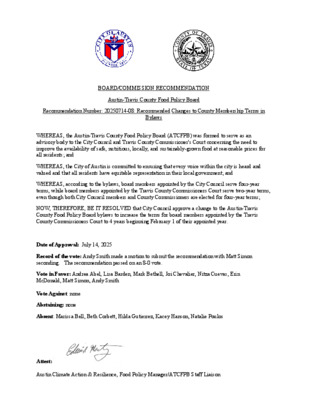
BOARD/COMMISSION RECOMMENDATION Austin-Travis County Food Policy Board Recommendation Number: 20250714-08: Recommended Changes to County Membership Terms in Bylaws WHEREAS, the Austin-Travis County Food Policy Board (ATCFPB) was formed to serve as an advisory body to the City Council and Travis County Commissioner's Court concerning the need to improve the availability of safe, nutritious, locally, and sustainably-grown food at reasonable prices for all residents; and WHEREAS, the City of Austin is committed to ensuring that every voice within the city is heard and valued and that all residents have equitable representation in their local government; and WHEREAS, according to the bylaws, board members appointed by the City Council serve four-year terms, while board members appointed by the Travis County Commissioners Court serve two-year terms, even though both City Council members and County Commissioners are elected for four-year terms; NOW, THEREFORE, BE IT RESOLVED that City Council approve a change to the Austin-Travis County Food Policy Board bylaws to increase the terms for board members appointed by the Travis County Commissioners Court to 4 years beginning February 1 of their appointed year. Date of Approval: July 14, 2025 Record of the vote: Andy Smith made a motion to submit the recommendation with Matt Simon seconding. The recommendation passed on an 8-0 vote. Vote in Favor: Andrea Abel, Lisa Barden, Mark Bethell, Joi Chevalier, Nitza Cuevas, Erin McDonald, Matt Simon, Andy Smith Vote Against: none Abstaining: none Absent: Marissa Bell, Beth Corbett, Hilda Gutierrez, Kacey Hanson, Natalie Poulos Attest: Austin Climate Action & Resilience, Food Policy Manager/ATCFPB Staff Liaison
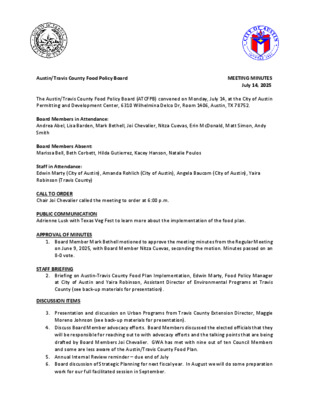
Austin/Travis County Food Policy Board MEETING MINUTES July 14, 2025 The Austin/Travis County Food Policy Board (ATCFPB) convened on Monday, July 14, at the City of Austin Permitting and Development Center, 6310 Wilhelmina Delco Dr, Room 1406, Austin, TX 78752. Board Members in Attendance: Andrea Abel, Lisa Barden, Mark Bethell, Joi Chevalier, Nitza Cuevas, Erin McDonald, Matt Simon, Andy Smith Board Members Absent: Marissa Bell, Beth Corbett, Hilda Gutierrez, Kacey Hanson, Natalie Poulos Staff in Attendance: Edwin Marty (City of Austin), Amanda Rohlich (City of Austin), Angela Baucom (City of Austin), Yaira Robinson (Travis County) CALL TO ORDER Chair Joi Chevalier called the meeting to order at 6:00 p.m. PUBLIC COMMUNICATION Adrienne Lusk with Texas Veg Fest to learn more about the implementation of the food plan. APPROVAL OF MINUTES 1. Board Member Mark Bethell motioned to approve the meeting minutes from the Regular Meeting on June 9, 2025, with Board Member Nitza Cuevas, seconding the motion. Minutes passed on an 8-0 vote. STAFF BRIEFING 2. Briefing on Austin-Travis County Food Plan Implementation, Edwin Marty, Food Policy Manager at City of Austin and Yaira Robinson, Assistant Director of Environmental Programs at Travis County (see back-up materials for presentation). DISCUSSION ITEMS 3. Presentation and discussion on Urban Programs from Travis County Extension Director, Maggie Moreno Johnson (see back-up materials for presentation). 4. Discuss Board Member advocacy efforts. Board Members discussed the elected officials that they will be responsible for reaching out to with advocacy efforts and the talking points that are being drafted by Board Members Joi Chevalier. GWA has met with nine out of ten Council Members and some are less aware of the Austin/Travis County Food Plan. 5. Annual Internal Review reminder – due end of July 6. Board discussion of Strategic Planning for next fiscal year. In August we will do some preparation work for our full facilitated session in September. 7. Review Board Member assignments a. All Board Members should share any highlights or accomplishments with Joi Chevalier to include in the Annual Internal Review. b. Staff to update recommendation number and formatting (add County seal) and send to Clerk’s Office. c. All board members to review advocacy table and send any notes to Amanda Rohlich d. Andy Smith and Joi Chevalier to send out talking points. DISCUSSION AND ACTION ITEMS 8. Discuss and take possible action on a request for by-law amendment to update Travis County …
Play audio
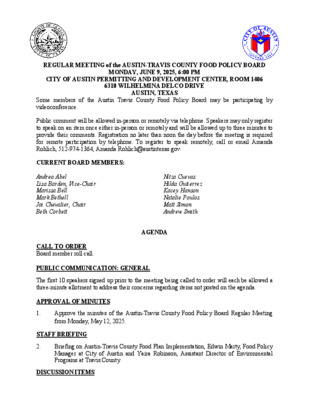
REGULAR MEETING of the AUSTIN-TRAVIS COUNTY FOOD POLICY BOARD MONDAY, JUNE 9, 2025, 6:00 PM CITY OF AUSTIN PERMITTING AND DEVELOPMENT CENTER, ROOM 1406 6310 WILHELMINA DELCO DRIVE AUSTIN, TEXAS Some members of the Austin Travis County Food Policy Board may be participating by videoconference. Public comment will be allowed in-person or remotely via telephone. Speakers may only register to speak on an item once either in-person or remotely and will be allowed up to three minutes to provide their comments. Registration no later than noon the day before the meeting is required for remote participation by telephone. To register to speak remotely, call or email Amanda Rohlich, 512-974-1364, Amanda.Rohlich@austintexas.gov. CURRENT BOARD MEMBERS: Andrea Abel Lisa Barden, Vice-Chair Marissa Bell Mark Bethell Joi Chevalier, Chair Beth Corbett CALL TO ORDER Board member roll call. Nitza Cuevas Hilda Gutierrez Kacey Hanson Natalie Poulos Matt Simon Andrew Smith AGENDA PUBLIC COMMUNICATION: GENERAL The first 10 speakers signed up prior to the meeting being called to order will each be allowed a three-minute allotment to address their concerns regarding items not posted on the agenda. APPROVAL OF MINUTES 1. Approve the minutes of the Austin-Travis County Food Policy Board Regular Meeting from Monday, May 12, 2025. STAFF BRIEFING 2. Briefing on Austin-Travis County Food Plan Implementation, Edwin Marty, Food Policy Manager at City of Austin and Yaira Robinson, Assistant Director of Environmental Programs at Travis County DISCUSSION ITEMS 3. 4. 5. 6. 7. Discuss Agriculture Valuations, Ian Dill Graduate Student at UT LBJ School of Public Affairs Discuss Board Member Advocacy Efforts Annual Internal Review Reminder Board discussion of Strategic Planning for next fiscal year Review Board Member Assignments FUTURE AGENDA ITEMS Discussion and scheduling of future agenda items. ADJOURNMENT The City of Austin is committed to compliance with the American with Disabilities Act. Reasonable modifications and equal access to communications will be provided upon request. Meeting locations are planned with wheelchair access. If requiring Sign Language Interpreters or alternative formats, please give notice at least 2 days (48 hours) before the meeting date. Please call Amanda Rohlich at Office of Sustainability, at 512-974-1364, for additional information; TTY users route through Relay Texas at 711. For more information on the Austin-Travis County Food Policy Board, please contact Amanda Rohlich at Office of Sustainability, at 512-974-1364.
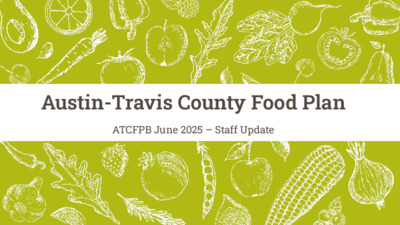
Austin-Travis County Food Plan ATCFPB June 2025 – Staff Update City of Austin Food Plan Updates Food Plan Dashboard Now LIVE City Staff Report Back to Council ● City staff will provide another Memo to Council in October 2025 ● City staff will provide a summary of the Food Plan Memo to the CWEP (Climate, Water, Environment, and Parks) Council Committee in fall 2025 Implementation Collaborative ● City and County staff developed an Interlocal Agreement to support a Food Plan implementation collaborative (Strategy 9.1) ● On May 8th, City Council approved an RCA to negotiate a contract with the County ● On May 13th, Travis County Commissioners Court approved the ILA with the City ● City staff are developing an RFP for support of an implementation collaborative. Will be released in mid-2025. ● Consultant should be on-board in fall of 2025. Food Plan Implementation Convening ● First Food Plan Implementation Convening occurred on May 9th ● Considering additional options for summer 2025 ● Next Convening in fall of 2025 Travis County Food Plan Updates Nothing new to report Thank You! Travis County Environmental Quality: Sustainability Programs www.austintexas.gov/food /austinsustainability
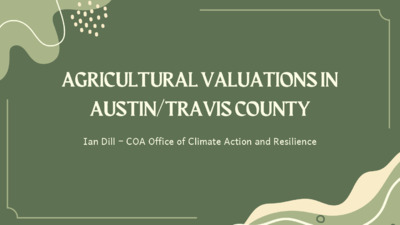
AGRICULTURAL VALUATIONS IN AUSTIN/TRAVIS COUNTY Ian Dill - COA Office of Climate Action and Resilience Background Travis Central Appraisal District (TCAD) creates the criteria for Agricultural Valuations based on primary use and property history. The State Comptroller releases guidelines for all Texas counties based on 1966 and 1978 Constitutional Amendments. Properties must pass 3 tests to qualify: “Principal Use” Test “Degree of Intensity” Test Time Period Test TCAD Structure TCAD has a big Board of Directors which is elected and run by a Chief Appraiser The Director appoints the Agricultural Appraisal Advisory Board, at least 2 of which are recipients of an Agricultural Exemption This has no decision-making authority over Exemptions! They advise on intensity standards Any issues with specific appraisals are handled by the Appraisal Review Board Appraisal Review Board members are private citizens appointed by TCAD Defining the Problem 3 main problems with Agricultural Valuations in Travis County: Agricultural Valuations ought to help stop the loss of Travis County Farmland. 1. Farmers in Austin/Travis County have trouble getting an exemption. 2. Not well aligned with goals in the Food Systems Plan. 3. Conspicuous properties are receiving valuations for land on or around large developments. Travis County has lost 11% of its farmland acreage and 21% of its farms since 2017. Average farm size has grown by 13% since 2017. Properties receiving a 1-d-1 exemption in the City of Austin (2023) 1-d-1 --- Open Space Agricultural Use (Dry Cropland, Pasture) 1-d-1B --- Beekeeping 1-d-1E --- Ecological Lab 1-d-1W --- Wildlife Conservation Barriers to Farmer Accesss The guidelines offer no way to measure intensity for a huge share of our crop mix! As of 2022, $14 million in crop sales out of the total $63 million are vegetables, melons, potatoes, sweet potatoes, nurseries, greenhouses, floriculture, or sod. Negotiations and challenges to appraisal process are complex and time-consuming. Food Systems Plan Alignment Stated Goals The Food Systems Plan (2024) aims for a diverse food inventory (Goal 4) and support regenerative food production (Goal 1). Assessment Process Assessors seem to take a snapshot of farms which misleads them about the intensity and farming techniques being used. Program-Wide Trends Even if only farms or conservation lands get exempted, the fact that the largest exempted properties are attached to a new factory and a racetrack indicate that the program is currently a development incentive. Recommendations - TCAD 1. Update and clarify intensity and size …
Play audio
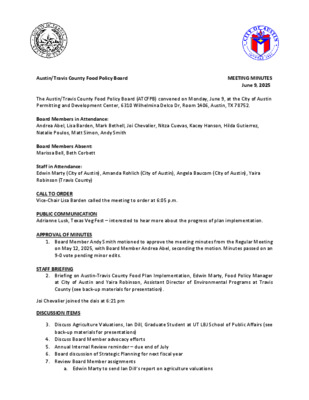
Austin/Travis County Food Policy Board MEETING MINUTES June 9, 2025 The Austin/Travis County Food Policy Board (ATCFPB) convened on Monday, June 9, at the City of Austin Permitting and Development Center, 6310 Wilhelmina Delco Dr, Room 1406, Austin, TX 78752. Board Members in Attendance: Andrea Abel, Lisa Barden, Mark Bethell, Joi Chevalier, Nitza Cuevas, Kacey Hanson, Hilda Gutierrez, Natalie Poulos, Matt Simon, Andy Smith Board Members Absent: Marissa Bell, Beth Corbett Staff in Attendance: Edwin Marty (City of Austin), Amanda Rohlich (City of Austin), Angela Baucom (City of Austin), Yaira Robinson (Travis County) CALL TO ORDER Vice-Chair Lisa Barden called the meeting to order at 6:05 p.m. PUBLIC COMMUNICATION Adrianne Lusk, Texas Veg Fest – interested to hear more about the progress of plan implementation. APPROVAL OF MINUTES 1. Board Member Andy Smith motioned to approve the meeting minutes from the Regular Meeting on May 12, 2025, with Board Member Andrea Abel, seconding the motion. Minutes passed on an 9-0 vote pending minor edits. STAFF BRIEFING 2. Briefing on Austin-Travis County Food Plan Implementation, Edwin Marty, Food Policy Manager at City of Austin and Yaira Robinson, Assistant Director of Environmental Programs at Travis County (see back-up materials for presentation). Joi Chevalier joined the dais at 6:21 pm DISCUSSION ITEMS 3. Discuss Agriculture Valuations, Ian Dill, Graduate Student at UT LBJ School of Public Affairs (see back-up materials for presentations) 4. Discuss Board Member advocacy efforts 5. Annual Internal Review reminder – due end of July 6. Board discussion of Strategic Planning for next fiscal year 7. Review Board Member assignments a. Edwin Marty to send Ian Dill’s report on agriculture valuations b. Amanda Rohlich to update board member matrix and advocacy plan so Board Members can review and send Amanda relevant updates c. Amanda Rohlich to send reminders to Board Members to submit any relevant meetings for getting those added to the meeting d. Amanda Rohlich to send out for with rank choice of recommendations for Board Members to determine priority e. Joi Chevalier and Andy Smith to coordinate on talking points f. Amanda Rohlich to send sample Annual Internal Review to Board Members for inspiration and then Board Members to send items to include in report g. Amanda Rohlich to send Board Members rank choice survey for future agenda items prioritization h. Send email out to all Board Members to see who is available for the July meeting i. …
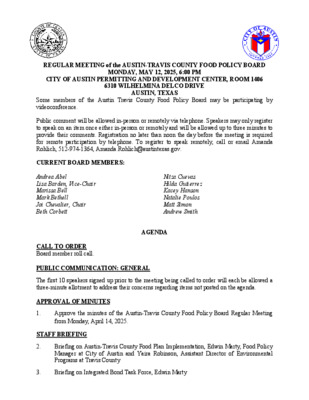
REGULAR MEETING of the AUSTIN-TRAVIS COUNTY FOOD POLICY BOARD MONDAY, MAY 12, 2025, 6:00 PM CITY OF AUSTIN PERMITTING AND DEVELOPMENT CENTER, ROOM 1406 6310 WILHELMINA DELCO DRIVE AUSTIN, TEXAS Some members of the Austin Travis County Food Policy Board may be participating by videoconference. Public comment will be allowed in-person or remotely via telephone. Speakers may only register to speak on an item once either in-person or remotely and will be allowed up to three minutes to provide their comments. Registration no later than noon the day before the meeting is required for remote participation by telephone. To register to speak remotely, call or email Amanda Rohlich, 512-974-1364, Amanda.Rohlich@austintexas.gov. CURRENT BOARD MEMBERS: Andrea Abel Lisa Barden, Vice-Chair Marissa Bell Mark Bethell Joi Chevalier, Chair Beth Corbett CALL TO ORDER Board member roll call. Nitza Cuevas Hilda Gutierrez Kacey Hanson Natalie Poulos Matt Simon Andrew Smith AGENDA PUBLIC COMMUNICATION: GENERAL The first 10 speakers signed up prior to the meeting being called to order will each be allowed a three-minute allotment to address their concerns regarding items not posted on the agenda. APPROVAL OF MINUTES 1. Approve the minutes of the Austin-Travis County Food Policy Board Regular Meeting from Monday, April 14, 2025. STAFF BRIEFING 2. Briefing on Austin-Travis County Food Plan Implementation, Edwin Marty, Food Policy Manager at City of Austin and Yaira Robinson, Assistant Director of Environmental Programs at Travis County 3. Briefing on Integrated Bond Task Force, Edwin Marty DISCUSSION ITEMS 4. Discuss Austin/Travis County Food Plan qualitative research coding as compared to AI coding, Natalie Poulos DISCUSSION AND ACTION ITEMS 5. 6. Report out from the April 23rd Joint Sustainability Committee Meeting, Marissa Bell. Review Board Member Assignments. FUTURE AGENDA ITEMS Discussion and scheduling of future agenda items. ADJOURNMENT The City of Austin is committed to compliance with the American with Disabilities Act. Reasonable modifications and equal access to communications will be provided upon request. Meeting locations are planned with wheelchair access. If requiring Sign Language Interpreters or alternative formats, please give notice at least 2 days (48 hours) before the meeting date. Please call Amanda Rohlich at Office of Sustainability, at 512-974-1364, for additional information; TTY users route through Relay Texas at 711. For more information on the Austin-Travis County Food Policy Board, please contact Amanda Rohlich at Office of Sustainability, at 512-974-1364.
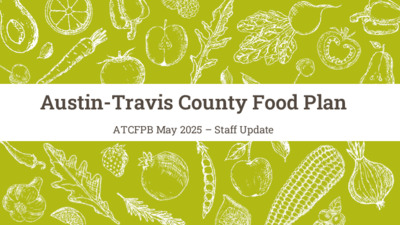
Austin-Travis County Food Plan ATCFPB May 2025 – Staff Update City of Austin Food Plan Updates Food Plan Dashboard Now LIVE City Staff Report Back to Council ● City staff will provide another Memo to Council in October 2025 ● City staff will provide a summary of the Food Plan Memo to the CWEP (Climate, Water, Environment, and Parks) Council Committee in fall 2025 Implementation Collaborative ● City and County staff are developing an Interlocal Agreement to support a Food Plan implementation collaborative (Strategy 9.1) ● On May 8th, City Council approved an RCA to negotiate a contract with the County ● On May 13th, Travis County Commissioners Court will vote on negotiating a contract with the City ● Once both the City and County have approval to negotiate a contract, we will negotiate a contract ● RFP for support of an implementation collaborative will be released in mid-2025 Food Plan Implementation Convening ● First Food Plan Implementation Convening occurred on May 9th ● Next Convening in fall of 2025 Travis County Food Plan Updates Travis County Parks Comprehensive Planning More community engagement opportunities open now - please participate! ● Second round of community engagement started April 12th and ends May 19th ● Public Workshops coming soon: ○ April 29th 12:00-1:00 p.m. ○ April 30th 6:00-7:00 p.m. ● https://outdoorengage.mysocialpinpoint.com/travis Communicating with Court Members Board Members appointed by Travis County Commissioners Court: It’s always a good time to communicate with the Court member (and/or their staff) who appointed you! ● Have final versions of Board-approved letters been shared with Court members? ● Please let me know how I can support you. Thank You! Travis County Environmental Quality: Sustainability Programs www.austintexas.gov/food /austinsustainability
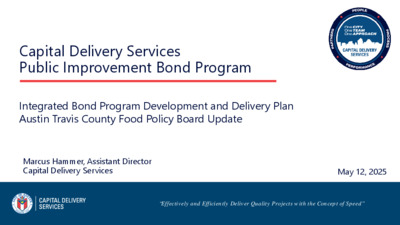
Capital Delivery Services Public Improvement Bond Program Integrated Bond Program Development and Delivery Plan Austin Travis County Food Policy Board Update Marcus Hammer, Assistant Director Capital Delivery Services May 12, 2025 “Effectively and Efficiently Deliver Quality Projects with the Concept of Speed” 1 AGENDA • CDS Overview • What is a General Obligation Bond Program? • Improved Bond Development Process • Staff Work Completed to Date • Guiding Principles, Technical Criteria, & Scoring Matrices • Progress to Date & Upcoming Milestones “Effectively and Efficiently Deliver Quality Projects with the Concept of Speed” 2 Created in 2023 with the goal of reducing project delivery time Who we are • Engineers • Architects • Project managers • Community Engagement Our partners • Consultants • Contracting teams • City asset owners • Community members • Mayor & Council Role in 2026 Bond Program One City – One Team – One Approach to effectively and efficiently deliver quality public projects. • Convene asset owner departments to develop needs assessment • Guide the process to ensure projects are vetted and scopes/schedules/budgets are accurate and realistic • Coordinate projects across departments to achieve mutual benefits What is a General Obligation Bond Program? Typical Bond Projects: • Flood and Erosion Control Improvements • New or Replacement City Facilities • Rehabilitation of Existing Facilities • Housing Infrastructure/Housing Projects • Street and Thoroughfare Improvements o Sidewalks o Traffic Signals • Park and Recreation Facilities • Public Safety Facilities (Fire/EMS/Police) • Land Purchase 4 What is a General Obligation Bond Program? Types of work NOT included: • Routine operations and maintenance activities o Potholes o Minor street repair o Landscaping maintenance o General building maintenance Improvements for short term leased space • • Code enforcement initiatives • Employee salaries (including police & fire) • AE/AW Capital Projects typically funded by using debt are funded via AE and AW revenue bonds, not General Obligation debt and thus are not for the 2026 GO Bond Program City of Austin | Capital Delivery Services Department | One City, One Team, One Approach to Capital Delivery 5 Improved Bond Delivery Process for 2026 2024 2025 2026 2027 2028 2029 2030 2031 2032 Council calls for Bond Election (Aug) Bond Election (Nov) BEATF Meetings, Council, and Public Engagement HOW WE’VE DONE BONDS IN THE PAST: Project Proposals RFP’s/RFQ’s Project Planning to develop scope, schedule, budget Design Construction WHAT WE’RE DOING NOW: Needs Assessment and Project …
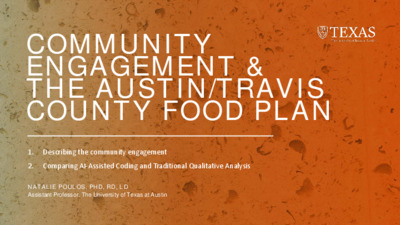
COMMUNITY ENGAGEMENT & THE AUSTIN/TRAVIS COUNTY FOOD PLAN 1. Describing the community engagement 2. Comparing AI-Assisted Coding and Traditional Qualitative Analysis NATALIE POULOS, PHD, RD, LD Assistant Professor, The University of Texas at Austin Why this study? • Qualitative researcher • Engaged in community food systems • Food Access Issue Area Working Group Research Aims: 1. Identify key food system concerns as described by community members 2. Compare AI-assisted qualitative coding and traditional content analysis Community Engagement Data • Public events included: – Community events – City-organized events – Online surveys • Two questions 1. What are your hopes & dreams for the Austin/Travis County food system? 2. What are your challenges & concerns with the Austin/Travis County food system? • 2,820 unique responses were documented – – 43 community events 27 zip codes Method & Analysis Comparison AI-Based Analysis Traditional Qualitative Analysis • • Public health practitioner based in local government GPT-4 + GPT for Sheets – Map comments to preidentified codes (issue areas) • • Define terms Set confidence – Asked AI to identify ‘themes’ (generative) based on community comments • • • “Analyze the following comments and provide me with the top themes related to food” Refined themes to 12 themes Expert review and discussion (3 themes added) – Map comments to ‘themes’ • GPT_MAP(Search_keys, Data, Confidence level, Top Results) • • • • Trained research team of at least two on reflexive content analysis Creation of codebook using preidentified content areas Testing reliability – Add in additional codes to highlight comments that did not fit original codes Manual coding – Issue areas + reflexive content codes Issue Area Code Comparison Food System Code Definition of Code1 Example of Key Terms2 • Direct comparison Markets & Retail of methods • Issue area codes Processing & Distribution How food is sold and purchased. What happens to food from where it is grown to when it reaches your plate, including how food is moved and processed. • Definitions and key terms based on City of Austin State of Food System Report (2022) Access & Consumption How we eat our food who struggles to get enough food, and what impact our consumption has on our health Food Production Where our food comes from, including everything from farming to ranching to backyard gardening Grocery Stores, Bodegas, Farmers Markets, Food Jobs, restaurants, Food Apps, Workers Rights, Selling Food Food Processing Facilities, Food …
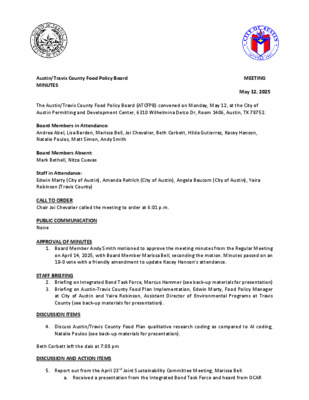
Austin/Travis County Food Policy Board MINUTES MEETING May 12, 2025 The Austin/Travis County Food Policy Board (ATCFPB) convened on Monday, May 12, at the City of Austin Permitting and Development Center, 6310 Wilhelmina Delco Dr, Room 1406, Austin, TX 78752. Board Members in Attendance: Andrea Abel, Lisa Barden, Marissa Bell, Joi Chevalier, Beth Corbett, Hilda Gutierrez, Kacey Hanson, Natalie Poulos, Matt Simon, Andy Smith Board Members Absent: Mark Bethell, Nitza Cuevas Staff in Attendance: Edwin Marty (City of Austin), Amanda Rohlich (City of Austin), Angela Baucom (City of Austin), Yaira Robinson (Travis County) CALL TO ORDER Chair Joi Chevalier called the meeting to order at 6:01 p.m. PUBLIC COMMUNICATION None APPROVAL OF MINUTES 1. Board Member Andy Smith motioned to approve the meeting minutes from the Regular Meeting on April 14, 2025, with Board Member Marissa Bell, seconding the motion. Minutes passed on an 10-0 vote with a friendly amendment to update Kacey Hanson’s attendance. STAFF BRIEFING 2. Briefing on Integrated Bond Task Force, Marcus Hammer (see back-up materials for presentation) 3. Briefing on Austin-Travis County Food Plan Implementation, Edwin Marty, Food Policy Manager at City of Austin and Yaira Robinson, Assistant Director of Environmental Programs at Travis County (see back-up materials for presentation). DISCUSSION ITEMS 4. Discuss Austin/Travis County Food Plan qualitative research coding as compared to AI coding, Natalie Poulos (see back-up materials for presentation). Beth Corbett left the dais at 7:08 pm DISCUSSION AND ACTION ITEMS 5. Report out from the April 23rd Joint Sustainability Committee Meeting, Marissa Bell. a. Received a presentation from the Integrated Bond Task Force and heard from OCAR b. Transportation and Public Works Department on Cap and Stitch. 6. Review Board Member Assignments. a. Staff to share Speak Up Austin engagement for Integrated Bond Development once live b. Staff to share Bond Election Advisory Task Force meeting information - webpage c. Staff to share follow-up email from May 9th Food Plan Implementation Collaborative convening d. Edwin Marty to share the CDFA Food System tools e. Edwin Marty to reach out to Maggie Johnson from AgriLife Extension to coordinate a presentation to the board at an upcoming meeting f. Staff to send Board member matrix and council members assigned for advocacy FUTURE AGENDA ITEMS Discussion and scheduling of future agenda items: Agricultural Exemption Briefing presentation in June ADJOURNMENT Chair Joi Chevalier adjourned the meeting at 7:36 pm. Minutes were approved at the June …
Play audio